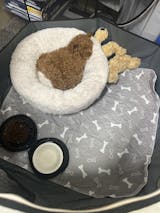Rawhide For Dogs - Is it Truly Good or Bad?
When most people think of a dog chewing on a bone, they see a dog gnawing on a typical rawhide bone. Rawhide bones are available in various sizes, ranging from tiny bones for small dogs to extra-sized chews for bigger breeds. Most dogs adore rawhide, joyfully chewing on rawhide bones for hours. It's no secret that rawhide is one of the most popular canine treats.
It may keep your dog entertained for hours, and many people feel rawhide is healthful and promotes oral health. On the other hand, rawhide can be quite hazardous to your dog.
So, let's take a deeper look at whether rawhide is harmful to dogs.
What is Rawhide For Dogs?
The inner cow or horse hides layer is used to make rawhide dog chews. The pieces are cleaned and chopped or ground throughout the production process. They are then formed into various shapes and sizes of chewable dog treats. Some rawhide snacks contain beef, chicken, or liver flavorings to make them more enticing to dogs.

It is chemically treated, cleaned in water, bleach, or hydrogen peroxide, and dried to transform rawhide from bovine to dog treat form. They are sometimes smoked to improve flavor.
Benefits of Rawhide Dog Chew
Aside from the amazing taste, the dental component is one of the most important advantages of natural dog chews like rawhide bones. Rawhide aids in the prevention of plaque and tartar buildup by rubbing and scraping the teeth clean, ensuring healthy teeth and gums.
Rawhide also keeps dogs occupied and promotes good behavior. Chewing is a natural way for dogs to cope with stress and boredom, and chewing on long-lasting rawhide allows them to express these feelings.
Dangerous
For one thing, rawhide bones and chews are notorious for causing digestive difficulties as well as intestinal blockage. They can even become lodged in the esophagus. Some dogs consume such enormous amounts of it without chewing that they wind up in the emergency room. This necessitates surgical removal of the huge portions.
Rawhide as chews for dogs are also dangerous for the following reasons:
Difficult to digest: Rawhide is tough to digest since it is a byproduct of leather, making it difficult to break down in a dog's digestive system. If a dog swallows a large piece whole, it may cause an obstruction in the esophagus or intestines. Furthermore, as they nibble and shred bits away from their rawhide chew, these pieces might pose choking dangers by becoming entangled in their trachea.
Chemicals used in processing: Worryingly, the chemicals used to treat the animal skin before it becomes a purchasable rawhide product might be harmful, especially if they are not adequately cleaned before drying.
In order to make the rawhide product more appealing, some businesses will dye it with food coloring or other colored chemicals, which can induce gastric discomfort, especially in dogs with sensitive stomachs, resulting in vomiting, diarrhea, decreased appetite, or a combination of these symptoms.
Contamination: Rawhide chews, like pet toys, can contain tiny levels of harmful substances. Salmonella or E. coli contamination is conceivable, like other pet (or human) diets. When these bacteria on rawhide treat come into contact with humans, they can become ill.

Digestive irritation: Some dogs are sensitive or allergic to rawhide or other ingredients used in its production. This can lead to a variety of issues, including diarrhea.
Choking or blockages: Rawhide bones and other food chews can pose choking and obstruction hazards. This is a far more serious threat than infection or stomach irritation. If your dog consumes big chunks of rawhide, it may become lodged in the esophagus or other regions of the digestive tract. A vet may be able to remove these bits rather simply through the throat, depending on their size and location. However, abdominal surgery is occasionally required to remove them from the stomach or intestines. A blockage can result in death if it is not cleared.
Tooth Damage: Chewing rawhide treats or dog bones is bad for your dog's dental health, especially if he is teething or an aggressive chewer.
While many owners provide rawhides to their pets to aid dental health, they may be doing more harm than good. If the rawhide is excessively rough, your dog's teeth may be shattered when chewing.
Give your power chewer a safe alternative dental chew that is designed to remove tartar from the outer layer of their teeth.
How Can You Determine If Rawhides Are Safe For Your Dog Or Not?
There are a few indicators that rawhide is safe as a dog chews for your dog.
- Contamination may occur if the rawhide is of poor quality or does not come from a well-known business with strict quality control processes. The method by which firms acquire and prepare rawhide is critical in deciding whether rawhide bones are appropriate for your dog.
- Another way to tell if rawhide is safe for your dog is to check the size. You want a rawhide bone that is large enough to chew on. You are familiar with your dog's habits, especially how he chews and eats. Take that knowledge and consider what shape and size would be best for your dog.
- Rawhides for dogs are designed to be eaten gradually, making them smaller over time. You don't want rawhide to be so little that it becomes a choking hazard or so small that it becomes a blockage if they don't chew it enough.

If you still want to give your dog rawhide chews, please be mindful of the following situations:
Puppies under six months old: Because puppies' mouths do not fully mature until around six months of age, it is not suggested that they be given rawhide chews until they are at least six months old, as they may be too firm for their developing jaws and teeth and cause irreversible harm.
Senior dogs: The same is true for older dogs, who have lower muscle tone and a poorer bone structure. Hard chews, like rawhides, can fracture the jawbone or teeth, resulting in severe dental or other problems.
Dogs with gastrointestinal disorders: Rawhides that have not been properly cleaned, flavored, or colored may produce unanticipated stomach troubles. If your dog has underlying gastrointestinal difficulties, avoid giving them rawhide.
If your dog has a history of digestive difficulties after eating rawhides, or if they have eaten rawhide pieces whole in the past, it's generally better to look for a safer alternative to rawhides. However, if your dog is in good health and has never had a problem with rawhides before, it may be okay to give them one. Regardless of your dog's past with rawhides, keep a tight check on them while they are chewing on a rawhide. Contact your veterinarian if you detect any gagging, regurgitation, or repeated swallowing.
What to Look for When Choosing Rawhide Dog Chews
Still, if you want rawhide bones as chews for your dogs, check for these indications so that your dog can be safe.
Check to see if the products are made in the United States. Unfortunately, companies making rawhides outside of the United States have fallen short of meeting quality control criteria for assuring the products have been adequately washed and cleaned of the harmful compounds utilized during processing.
Choose the appropriate size. As previously said, do not choose a rawhide that is too big or too little for the size of your dog, as this might lead to problems later on.
When your pet is chewing, keep an eye on him or her at all times. Remove any bits that they may tear off before they become a choking or blockage threat or if they become too old, unclean, or contaminated. Teach your dog to "drop it" to make chewing easier and less unpleasant for everyone (this helps prevent resource guarding of high-value chews).
Do not buy rawhide that has been colored, dyed, or flavored. This can assist in avoiding gastrointestinal upset caused by chemical flavorings and dyes.
Finally, never leave your dog alone with a chew toy. It is critical to always monitor your dog while they chew to protect their safety. This will also help you understand how they chew so that you can continue to offer them the safest and greatest type of chews in the future.

Alternatives of Rawhide for Dogs
Rawhides for dogs are popular chew toys, but they aren't always the safest option. Although rawhides are generally safe for some dogs and the hazards are modest, the risks are still present and should not be overlooked. Some dog owners believe that the risks involved with rawhides are simply not worth taking.
Whether you feed your dog rawhides or not, he or she needs to chew, which means you must locate a safe, healthful treat for your dog to chew on. Here are several rawhide alternatives for dogs:
Carrots: While baby carrots are a nice, healthy on-the-go dog treat, huge, full-size carrots are an excellent choice when your dog needs to chew. Carrots are not only nutrient-dense but also low in calories, making them an excellent choice for dogs who could benefit from losing a pound or two.
Pegetables: Pegetables are dental dog chews made from some of the greatest vegetables for your dogs, such as peas, sweet potatoes, and carrots, and can be found in most pet stores. These sweets are maize, grain, gluten-free, and easily digestible. They can also assist in cleaning your dog's teeth and refresh their breath.

Bully sticks: They are popular among my dog owners since they are free of chemical additives and preservatives. Bully sticks can also survive for a long time, but many have a strong stink.
Antlers: Antlers from deer or elk are high in zinc, calcium, potassium, and manganese, plus they're not nasty or oily like many other dog chews. However, there is a disadvantage to antlers. They are quite hard, and if your dog chews too violently, he or she may fracture a tooth. Elk antlers are slightly safer than deer antlers, but keep a watchful eye on your dog when they chew them, regardless of which antlers you choose.
Salmon skin: Salmon skin bones are exactly what they sound like: salmon skin bones! These bones are ideal for dogs who are allergic or sensitive to other proteins and those who are particular about veggies. These snacks are great for your dog's coat but don't leave one alone with him. They are jerky, and if your dog swallows a portion instead of chewing it, they may become a choking hazard.
Homemade treats: Many individuals love the homemade touch and go to great lengths to prepare special treats for their dogs.
Beef bouillon, eggs, banana, peanut butter, wheat germ, powdered milk, and other ingredients can be used to make delectable homemade dog treats. As with any dish, your options are only limited by your imagination, as long as it doesn't stray too far into the sugary, high-fat realm. Of course, avoid using poisonous items, such as grapes and raisins, onion and garlic, chocolate, caffeine, macadamia nuts, and the artificial sweetener xylitol.
As you can see, there are many rawhide alternatives for dogs, but it's vital to remember that there is no such thing as a completely safe chewing treat. Keep an eye on your dog whenever he or she is munching on a reward. An untreated blockage can be fatal, and just because your dog is chewing on a rawhide substitute doesn't mean he isn't at risk of choking.
Final Words from Us
Don't endanger your dog's health (or life) by giving him a rawhide bone. Before administering it to your dog, look over the ingredients list. When providing any treats to your dog, keep in mind that obesity in dogs is quite dangerous. You don't want them to suffer due to your blunders, do you?
Consult your veterinarian if you believe your dog is at risk from rawhide consumption or if you are unsure of what chewy alternatives to give them.
















